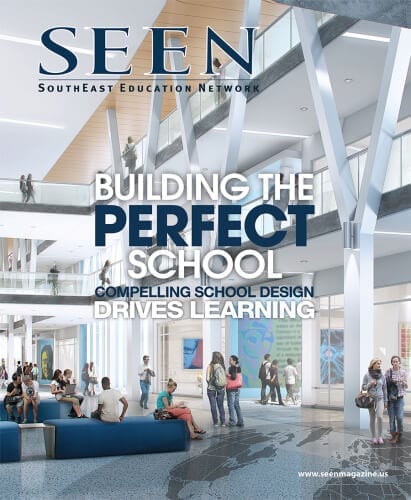by Dr. Billie J. McConnell
This is the second installment of The Perfect School series originally published in SEEN Magazine.
We must start with the “perfect school.” Until we come to an agreement on what students should learn and how they will best learn, we can’t choose the technology that allows us to meet our goals. We must continue to discuss this at the national and state levels, but it must also be discussed at the local level where the decision to buy technology is being made.
For decades we have been assuming, at least by our practice, that our methods of teaching and the format of school was already set, so we have been looking for ways technology would improve it or make it more efficient. We have been assuming that if we get just the right technology we will have more success. We have been working on the assumption that if we keep doing what we have always done, but with a different tool, then we could expect a different result.
Could there be two more controversial education topics? Technology and the perfect school are both topics of debate, research, teachers’ lounge discussions, parent meetings, board meetings, political rallies and countless articles. They cause mild mannered people to go from Dr. Bruce Banner to the Hulk. So, why not put them together in one big controversial article?
It reminds me of the picture of a horse hitched to the front of the Model T delivering mail. How many schools have purchased technology, implemented it into the current system, and then wondered why there was no change in student success or engagement? I can’t begin to count the number of times I have had a teacher or administrator say, “There has to be more to this!” Well, there is. But, it is not about the technology, it is about a school’s learning environment.
We must rid ourselves of the old industrial model mentality and begin thinking about what is best for today’s students. We can’t just tweak, but in the words of Clayton Christensen we must be “disruptive.” School should be about helping each student realize and develop his or her gifts and learn how they can use those gifts to live well and to improve the world around them. We can’t assume that the way we taught and structured schools even 10 years ago will properly prepare students for the world that they will enter.
I believe that we must start with the premise that all students are capable of learning given the right environment, tools and time. In the words of Carol Dweck, we need to develop a “Growth Mindset.” I believe school should resemble how we daily learn as adults and how we initially learned before we went to school. When we need to do something, we question, inquire, discover, try, fail, grow, learn and master. Learning is our daily practice, not an act of achieving a grade or being compliant. Students need to demonstrate what they have learned by accomplishing meaningful tasks through multiple means. Failure is not something to fear, but an expected part of the learning process.
Subjects are not isolated into their own classrooms, but are taught together and integrated into the learning process through real life scenarios and simulations. If it takes six weeks to learn something, then it is because that is how much time we needed to learn it, not because that was the allotted time on the schedule. We learn the basics because we need to know them to solve our problem or accomplish our task. Currently we teach “the fundamentals” first and we do it in isolation and out of context, because we might need to know it someday. Let’s learn what I call “Cyclical Blooms.” Let’s present students a problem or challenge that has a purpose, let them figure out what they need to accomplish it, learn the fundamentals that are needed, and then proceed to meet the challenge through collaboratively trying, failing, learning and trying again until they master it.
Learning vs. Teaching
I have switched my thinking from schools being about teaching to being about learning. For today’s students, teaching is what a teacher does while the students remain passive. Learning is about what the student does. Classrooms need to be re-designed to focus on students being allowed to be active in constructing their knowledge, as opposed to what the teacher should do to disseminate information.
The model of a teacher being the sole dispenser of knowledge has created a generation of students who do not know how to learn, are more concerned about grades than learning, and who often “check out” of school because there is nothing that challenges them. School is boring! When school is about challenging students with meaningful problems and allowing them to discover and develop their skills and talents, then school will become a place that students want to attend.
You could say that moving from teaching to learning is similar to the video game model. I am not advocating that schools should be a video game, but I think video game designers have figured something out that has eluded us educators. In a video game you don’t read a manual and sit through countless  hours of lectures to prepare to play the game. You learn by playing the game. But wouldn’t that be frustrating? Apparently not, since we have over one billion gamers in the world now. When you ask a gamer why they keep playing, they will tell you because it is fun. But, what is fun about it? It’s fun because it is challenging. It’s fun because you have to figure out how to get to the next level. What prize do you get for getting to the next level? Well, you get a harder challenge. They are motivated to keep playing because they want to solve a challenge in order to get a harder challenge.
hours of lectures to prepare to play the game. You learn by playing the game. But wouldn’t that be frustrating? Apparently not, since we have over one billion gamers in the world now. When you ask a gamer why they keep playing, they will tell you because it is fun. But, what is fun about it? It’s fun because it is challenging. It’s fun because you have to figure out how to get to the next level. What prize do you get for getting to the next level? Well, you get a harder challenge. They are motivated to keep playing because they want to solve a challenge in order to get a harder challenge.
You may also note that today games are typically played in a collaborative environment and they create and follow a set of societal rules that you must follow if you want to continue playing. Gamers learn from each other and work together to accomplish the goal. If you look carefully at how video games are designed, they meet all of the motivators described by Daniel Pink (Autonomy, Purpose and Mastery) and the players develop all of the ISTE Standards (Critical Thinking and Problem Solving, Collaboration and Communication, Research, Creativity and Innovation, Digital Citizenship and Technology Use). School doesn’t have to look like a video game, but shouldn’t it have all of the same characteristics that cause students to keep playing video games?
Meaningful Technology
What about the technology? It has been here all along. If you try to think about technology as a substitute for teaching, then you have missed the point. In the perfect school, technology is ubiquitous and invisible. In the perfect school, students have the tools they need and they use a tool because they need it to accomplish a task. In the perfect school, you see students using technology all of the time and in many different ways, but they are not talking about the technology, they are talking about what they are learning and how they will accomplish their task. Which technology do they need?
The one that best accomplishes the goal. So, if your school doesn’t know what the goal is or what challenges you are going to present your students, then it is impossible to choose the right technology. You design the perfect school and then you choose the technology that fits. What we have been doing for decades is buying technology and then trying to make it fit an old model or, in some cases, changing our classrooms to fit the technology. That’s backwards.I will never forget the phone call that I got one day from a school administrator. They had just bought an iPad for every student and they put 144 apps on each of them. His question was, “Now what?” Now what?! My question was “Why?” I am not opposed to iPads or apps, but don’t buy them until you know why you need them and what you want to accomplish. Technology in the perfect school is the technology that meets the school’s vision of a learning environment that will allow the students to develop the skills they will need for their future.
Authors
Dr. McConnell is the President of Connected Consulting, a consulting firm that works with school leaders to develop technology integration plans that include visions for change, classroom goals, and capacity building for school leaders and teachers. For information, visit www.connectedconsulting.com.
Original article, Technology in the Perfect School, appeared in SEEN Magazine. Check out more thought leadership profiles in the latest edition of SEEN Magazine!

